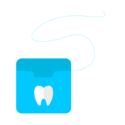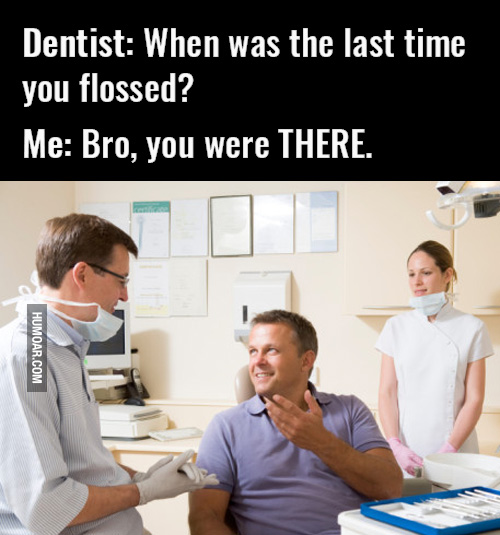
|

|

|

|

Making Flossing Easier
Flossing is an important part of maintaining your oral hygiene. As well as controlling decay and infections, flossing will be an important step in keeping your breath fresh. Your toothbrush alone will not be able to reach the tight spaces between the teeth—no matter how excellent your brushing is!
In reality, most people know they need to floss, but struggle to incorporate it into their daily routine. One obstacle to this can be dentists themselves—many patients report that they feel judged negatively by dentists who repeat, “you need to floss!” at every check-up. At our clinic, we prefer to offer practical encouragement and support instead of guilt- or shame-based approaches. We hope to share some of them with you today. So for the time between now and your next check-up, here are some practical tips which may help flossing work for you!

-
Remembering to floss.
One of the most frequent reasons patients cite for not flossing is simply not remembering! This applies to any new habit you try and work in to your life—like using a Keep Cup or bringing reusable bags to the supermarket—but thankfully there are two very easy ways to help you remember to floss!
Just like waking in the morning, setting an alarm or reminder on your phone takes no effort and will prompt you every day.
Alternatively, physically putting your floss right next to your toothbrush on display gives you a twice-daily daily cue to jump in there and get those germs out!
-
There’s no time like the present.
Don’t get bogged down fretting about when to floss. Flossing aims to disrupt the germs that build up in that snug space between the teeth, and it doesn’t matter when that happens. Whether it’s before or after brushing, in the morning, day or night, when you floss is all a matter of personal preference.
Personally, I prefer to floss at night prior to brushing. This is so I can get in and brush those germs straight off the teeth once I’ve flossed them out, and because I often find I don’t have enough time in the morning to floss. More importantly, I’m a bit of a zombie before my coffee has kicked in so flossing is just not going to work for me then.
But, really, if you’re a shift worker, have kids to put to bed at night, or one of those mysterious morning people, then flossing in the morning might work best! You don’t even need to floss at the same time as your brushing if that is what works for you. Keeping floss in your car or handbag for after lunch can be a great idea too!
The only time I wouldn’t recommend flossing is in public—surprisingly, other people don’t seem to appreciate that.
-
Get the right flossing technique.
At any check-up we are more than happy to show you the best technique for flossing—a simple up and down movement is not the most effective way to floss. If you are going to take the time to floss, you might as well be getting the best possible job done.
If you forget, or have felt embarrassed to ask your dentist how, there are some fantastic ‘how-to’ videos online that show correct flossing technique at home to practise. Dr Claire and I are both more than happy to help with this in person—and we certainly don’t feel like asking how to floss is silly. It takes a bit of practise to get right, but is very quick to do once you know how.
If you would prefer to look at a video at home, which is less than 2 minutes long and very straightforward, try this one.

-
All tangled up.
One of the most common reasons patients attribute to not regularly flossing is due to them struggling to fit all that string (and fingers!) all the way to the back teeth. Trying a hand-held disposable flosser can be a great way to make flossing easier for your routine. These can be single-use disposable units or units such as the Listerine brand REACH flosser, which has disposable floss heads on a reusable toothbrush-length handle.
Both of these options can stop flossing from being too time-consuming or difficult, so it is easier to fit into your busy daily schedule. However, traditional string floss works just as well (and both has less waste and cost per use!) for cleaning between the teeth!
-
What about a waterpik?
It’s certainly better than not flossing at all. The analogy I like to use is that a waterpik works similar to if you cleaned your dishes by simply holding them under the stream of your tap. Water works well to dislodge loose debris and food, but usually isn’t enough for anything stuck on. The reality is that after any 24 period, the germs on your teeth develop into a smarter network (biofilm), making them stick better to the surface. This means that water alone may not be enough to get rid of them. Because waterpiks are a new technology, there is little good quality evidence about how effective they actually are. Like your dishes, in between your teeth may need some sort of mechanical aid in cleaning, rather than just water.
Having said that, many of my patients report that they really love using their waterpik. Waterpiks can also be a quick and easy to help dislodge food around braces/orthodontic work, but I would not consider this to be enough to replace flossing alone.
-
The right tool for the job.
Another alternative to floss is an interdental brush, common brands being TePe, CareDent, or Pikster. They can be very helpful in situations where the gaps between the teeth are larger, like in cases where there has been gum disease. Interdental brushes are also often used underneath fixed orthodontic retainer wires. For these difficult or larger spaces between teeth, interdental brushes can make cleaning easier or more effective. However, it is best to ask your dentist at a check-up if this is the right tool for you as using the wrong size can be damaging or ineffective.

-
Brace yourself—floss threaders.
Aside from interdental brushes (see above #6), there are products that exist that make cleaning around braces and retainer wires easier. These types of appliances often prevent conventional flossing—but this does not get you out of having to do it! Without flossing, decay or gum disease can rapidly form in otherwise healthy areas. Superfloss (Oral B branded), and floss threaders basically act to allow you to coax your floss underneath these wires.
This is also very important in cleaning around fixed tooth replacements such as bridges. One of the most common reasons for failure of a bridge is decay forming on the teeth due to the difficulty of cleaning them well.
It is best to check your technique with a dentist or let us know at your next check if you are having issues with use of these products. While it may be harder to clean around these areas, it is less than the headache of having to undergo further dental treatment for any decay or gum disease that may have formed!
If this was helpful for you, or if you have any feedback – please let us know! Otherwise I hope this encourages you to find an easy way to work flossing into your busy schedule!





